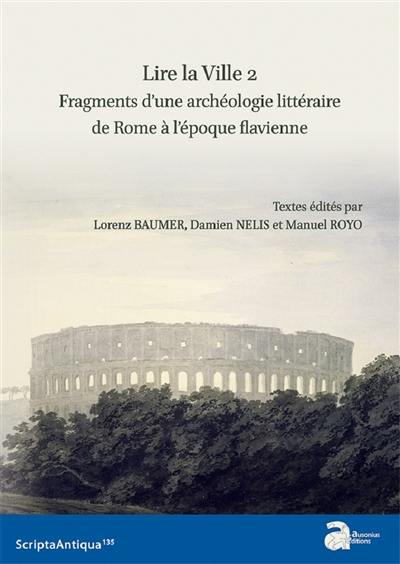
Fiche technique
Format : Broché
Nb de pages : 244 pages
Poids : 460 g
Dimensions : 17cm X 24cm
ISBN : 978-2-35613-348-9
EAN : 9782356133489
Fragments d'une archéologie littéraire de Rome à l'époque flavienne
Quatrième de couverture
Lire la Ville 2
Fragments d'une archéologie littéraire de Rome à l'époque flavienne
Le présent ouvrage rassemble des communications tenues à Genève en 2016 autour du rapport entre la littérature latine et l'espace urbain. Une première série d'études, parue en 2014 (Lire la Ville. Fragments d'une archéologie littéraire de Rome antique, ScriptaAntiqua 65), prenait pour objet des textes essentiellement d'époque augustéenne. Elle montrait comment les allusions littéraires à l'espace concret de la ville ne se limitaient pas à de simples informations topographiques mais traduisaient tout un imaginaire lié aux programmes politiques et monumentaux que la paix retrouvée sous l'égide de l'empereur Auguste avait pu mettre en oeuvre.
Il a paru intéressant de vérifier si, à distance de quelques générations et après la fin de la première dynastie impériale, ces mêmes mécanismes ne se retrouvaient pas après l'avènement d'une nouvelle dynastie et la seconde grande transformation urbaine de Rome. L'incendie de 64 p. C., les bouleversements qui accompagnent la mort de Néron et la nouvelle guerre civile qui la suit créent les conditions d'un cycle de reconstructions et de constructions comparable à celui qui suivit les événements de la fin de la République. L'originalité tient à ce que poètes et prosateurs flaviens qui en parlent s'inspirent de leurs prédécesseurs, que ce soit pour les suivre ou au contraire pour s'en démarquer. Ce système de références plus ou moins explicites fait écho à la manière dont la nouvelle dynastie entend se positionner par rapport à l'ancienne. Onze communications composent ce portait littéraire de Rome autour de poètes et d'écrivains comme Stace, Martial ou Pline l'Ancien, un portrait qui recoupe les grandes lignes du nouveau paysage urbain et des monuments qu'élèvent alors les Flaviens. L'entreprise littéraire servira même de modèle à la Renaissance pour représenter à son tour la Florence des Medici, preuve s'il en est de son importance.
This book gathers together a set of papers first delivered as lectures at a conference held in Geneva in 2016. The aim of the colloquium was to study the relationship between Latin literature and urban space in Flavian Rome. An earlier volume, published in the same series in 2014 (Lire la Ville. Fragments d'une archéologie littéraire de Rome antique, ScriptaAntiqua 65), had focused mainly on texts from the Augustan period, in an attempt to show how literary allusions to the real spaces of Rome and its environs were not limited to the communication of simple topographical information, but also reflected an entire imaginary closely linked to the political and monumental building programmes of Augustus.
In light of that study, it seemed appropriate to try to investigate these same literary interactions after the end of the first imperial dynasty, and to see whether they were still to be found in operation after the advent of a new dynasty and in relation to the second great urban transformation of Rome. The fire of 64 AD, the upheavals which accompanied the death of Nero, and the civil war which followed all created the conditions for a cycle of reconstructions and constructions comparable to that which followed the events of the end of the Republic. But an original aspect of the Flavian context is that its poets and prose writers are greatly inspired by their Augustan predecessors, both following them to a considerable extent but also taking new paths. This more or less explicit literary system echoes the way in which the new dynasty intends to position itself in relation to the old. Eleven contributions make up this literary portrait of Rome around poets and writers like Statius, Martial, and Pliny the Elder, a portrait that reflects the main outlines of the new urban landscape and the major monuments built by the Flavians. This literary enterprise went on to serve as a model for the representations of Renaissance Florence of the Medicis, a striking proof of its longevity and influence.





